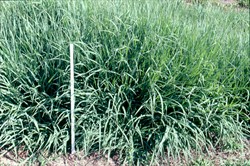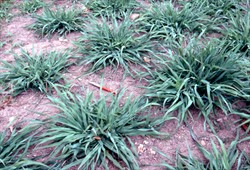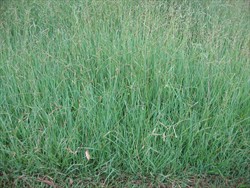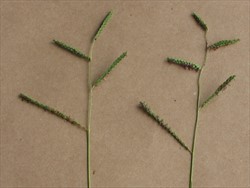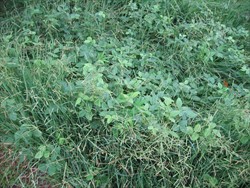Paspalum lepton
Tropical Forages
Paspalum lepton Schult.
Paspalum nicorae Parodi; Paspalum plicatulum Michx. var. arenarium Arechav.
Family: Poaceae (alt. Gramineae) subfamily: Panicoideae tribe: Paspaleae subtribe: Paspalinae group: Plicatula.
Rhizomatous perennial, rhizomes mostly in top 10 cm of soil, spreading below the soil surface (unlike P. notatum with stolons/rhizomes spreading on soil surface). Rhizome development varying from short, producing almost tufted appearance, to long, thin (leptomorphic), 2–3 mm diameter, and extending >25 cm/yr forming sward. Culms erect, 20–50 (–80) cm tall, with basal leaves and short internodes. Leaf blades erect to semi-erect, flat or conduplicate, linear-lanceolate (rarely lanceolate), pale green to grey green (often with lighter-coloured midrib), glabrous or pubescent, (13–) 20–30 (–36) cm long, (3–) 5–7 (–9) mm wide, varying with provenance; ligule eciliate mambrane 0.5–2.5 (–4) mm long. Inflorescence comprising (2–) 3–5(–6) racemes, 2–7 cm long; spikelets ovoid-elliptical, 2.4–2.9 mm long and 1.2–1.8 mm broad; glume with very short, fine hairs visible only under magnification; caryopsis dark chestnut brown and pronouncedly convex. About 450,000 seeds per kg.
English: brunswick grass; brown seeded paspalum (more appropriate for Paspalum plicatulum Michx.)
Latin America: grama cinzenta (Brazil)
Native:
South America: Argentina (Córdoba, Buenos Aires, Corrientes, Entre Rios, Formosa, Santa Fe); Brazil (Mato Grosso do Sul, Rio Grande do Sul, Santa Catarina), Paraguay (Central, Concepción, Cordillera, Guaira, San Pedro); Uruguay
Naturalized:
Northern America: USA (southeast)
Australasia: Australia (Queensland, New South Wales)
Forage
Used for permanent pasture in the subtropics, with possible application for hay and silage. Not suited to short-term pasture due to difficulty of control.
Environment
Ground cover (soil conservation) under trees, stabilisation of waterways, traffic areas, buffer strips, filter strips, field borders, water disposal areas and similar critical areas.
Soil requirements
P. lepton is found on sandy soils, Luvisols, Argisols and Neosols of the Campanha, Depressão Central, Serra do Sudeste and Planície Costeira in Rio Grande do Sul state, Brazil, granitic sands in Córdoba Province, Argentina, and red sandy loams in south-east Paraguay. It is also found in rocky environments. Perhaps best-adapted to sandy and other friable, free-draining soils, but has also been grown successfully on hard-setting sandy clay loams, provided internal drainage is fair to good and moisture is adequate. Although it is often found on infertile soils in native and naturalized situations, it responds to improved fertility. It prefers acid to slightly alkaline soils with a pH <8.
Moisture
Rainfall at collection sites varies from about 800 to 1,500 mm/yr, and in cultivation, various genotypes have been successful over a similar range, and to as low as 700 mm/yr. P. lepton is drought tolerant. It survives short periods of flooding, but does not tolerate permanent waterlogging.
Temperature
P. lepton extends from about 21º S in Brazil to 35º S in Uruguay and Argentina. Most of the more attractive forage types come from Rio Grande do Sul in Brazil, between about 29º and 30º S. Altitudes are mostly from near sea level to 500 m asl. Average annual temperatures over its distribution range from about 16 in Uruguay to 23 ºC in Brazil, and frosts are experienced. The species has become naturalized in areas experiencing temperatures as low as -15 ºC (USA) and recording an average of 35 days with screen temperature <0ºC each year (Australia). The foliage has frost tolerance comparable with that of Cenchrus clandestinus, but is burnt off by severe frost and makes no further growth during the winter when grown in cool climates. Deep rhizomes are protected from frost by the soil, and even severely frosted plants recover quickly with the advent of warmer, moist conditions. The plant has good cool season growth, producing about 50% more dry matter than kikuyu, Cenchrus clandestinus, during the 6 coolest (also driest) months at 27º S. Although vegetative growth begins in spring and continues until autumn, over 80% of the forage is produced during the 6 warmer, moister months.
Light
Has moderate shade tolerance, growing under pine trees and eucalypts.
Reproductive development
Most lines commence flowering in summer in the subtropics (June in the northern hemisphere, December in southern hemisphere) and continue flowering for about four months. Flowering terminates with shortening days and cooler temperatures. Foliage production is reduced during flowering, but unlike in P. dilatatum, is still significant. It does not flower at 15º latitude (i.e. at low latitudes).
Defoliation
It is extremely tolerant of defoliation, forming a low dense sward under regular mowing or continuous grazing, and regenerating well after grazing or cutting. Yields are reduced with more regular defoliation.
Fire
Recovers well following fire.
Guidelines for establishment and management of sown forages.
Establishment
Seed has low dormancy and can be planted relatively fresh. It is normally sown at 2–3 kg/ha, or up to 10 kg/ha if more rapid ground cover is required. It is best sown into a well-prepared seedbed, but can be oversown onto a herbicide treated sward if cultivation is undesirable. Seedlings develop more rapidly than those of Paspalum notatum, with the potential to give complete cover in the first season. Paspalum notatum may take two or three seasons to achieve the same level of cover. In areas that are not heavily frosted, it can be planted in autumn with a light sowing of ryegrass (Lolium spp.), giving plants an early start the following spring. In such cases, the ryegrass should be grazed regularly.
Fertilizer
It is very responsive to applied nitrogen, up to levels of 300 kg/ha/yr, depending on the soil mineral N status. However, the greatest response generally occurs at about 100 kg/ha/yr N. Availability of other nutrients, particularly P and K should be monitored and corrected if required.
Compatibility (with other species)
P. lepton is very competitive, suppressing Axonopus fissifolius, Imperata cylindrica, Digitaria didactyla and tussock species such as Heteropogon contortus. It competes effectively with Paspalum notatum and is showing promise in suppressing invasive grasses such as Sporobolus pyramidalis and Eragrostis curvula that can dominate pastures based on other less-competitive grasses. It suppresses the intractable broadleaf weed, Heliotropium amplexicaule. Production of companion legumes is also affected by P. lepton's competitiveness. In the lowland subtropics, warm season legumes such as Vigna parkeri and Aeschynomene falcata that normally combine with warm season sward grasses are suppressed by P. lepton. Arachis spp. are less affected. Cool season species can be affected in vigorous first year stands, but once there is ecological equilibrium, productive stands of temperate legumes (e.g. Trifolium subterraneum) are maintained. This level of competitiveness is less pronounced in the upland subtropics or other cooler environments.
Companion species
Grasses: Not normally sown with other grasses, but will form associations in some situations with Digitaria eriantha, Lolium spp., and Paspalum notatum.
Legumes: Adesmia spp., Arachis glabrata, A. pintoi, Lotus uliginosus, Medicago spp., Trifolium repens, T. subterraneum.
Pests and diseases
P. lepton is generally not seriously affected by insects or disease. Some genotypes are subject to ergot infection caused by Claviceps paspali. Lepidopterous larvae such as sod webworm (Herpetogramma licarsisalis Pyralidae) and lawn armyworm (Spodoptera mauritia Noctuidae) often infest well fertilized, vigorously growing stands during the wet season. African black beetle (Heteronychus arator Scarabaeidae) is suspected of causing damage to roots and rhizomes, leading to yellowing of shoots.
Ability to spread
This ability varies with genotype. While many accessions exhibit strong rhizome development, and spread vigorously in this way, others have limited rhizome development and tend to form broad tussocks. Most genotypes tested seed prolifically in warm environments, hence providing the potential for significant spread. In practice, it is spread by livestock either through seed caught in hooves or through ingested seed, but not extensively. As with many members of the Plicatula group, seed survival in humid conditions is limited, and development of banks of soil seed is unlikely.
Weed potential
It is difficult to control with cultivation due to rhizome survival and regeneration, although several cycles of cropping with taller species can result in control. It is also difficult to control with herbicides. Less palatable types have been listed as weeds, such as the low growing, rapidly maturing type that has become widely naturalized in the Rappville-Casino district of northern NSW, Australia, having been introduced from the USA by a farmer in the 1940s.
Nutritive value
In 6-week regrowth, CP levels ranged from 7 to 14 (av. 10)%, P levels from 0.15 to 0.26 (av. 0.18)%, Ca from 0.37 to 0.77 (av. 0.54)%, and Mg from 0.16 to 0.38 (av. 0.24)%. Na levels were below the level of quantitation. IVDMD ranged from 54 to 64 (av. 60)%, ADF from 34 to 41 (av. 38)%, and NDF from 62 to 70 (av. 66)%.
Palatability/acceptability
Cultivars have been selected partly on the basis of leafiness and palatability. If regrowth is kept relatively young and leafy, (say 34 weeks, and no more than 6 weeks), it is readily consumed. As with most grasses, it becomes unpalatable if not grazed frequently. However, there are genotypes that become fibrous more rapidly than others, and are not eaten readily, even in more intensive systems.
Toxicity
No oxalate (soluble and total) was detected in 6-week old dry matter. No problems have been recorded.
Dry matter
In Australia, the average annual yield over two years of one accession, fertilized heavily with N and grown on a moist soil in a warm coastal environment, was 28 t/ha DM. This is the average for grass cut at 30- and 60-day intervals at 5 cm. Yields in less favourable environments but still with N fertilization may be as low as 10 t/ha DM. In the USA, when cut at various intervals at 3 mm and fertilized with N, the average yield ranged from 9 to 12 (av. 10.6) t/ha/yr DM over two years, depending on cutting frequency.
Animal production
Average liveweight gain of 265 kg heifers stocked at 5/ha over 3 autumn months, grazing a pure stand of P. lepton fertilized with 110 kg/ha N and in the absence of any supplementary feed, was 0.6 kg/hd/day (1.3 kg/hd/day in the first month). Reduced animal growth rates in subsequent months reflected the onset of drier, cooler conditions, and declining grass growth rate.
Tetraploid, 2n =4 x = 40. Research has demonstrated that P. lepton is a facultative apomict which reproduces by apospory and pseudogamy. However, a small proportion of progeny from nursery-produced seed of P. lepton growing adjacent to P. plicatulum, proved to be intermediate between the two, suggesting sexual reproduction is possible, at least in some lines.
Paspalum lepton seeds freely, presenting the crop at 15–20 cm above the foliage and showing little tendency to shatter. The stand is maintained as a low sward to maximise tiller numbers until initial inflorescences appear (about late June/early July in the northern hemisphere, late December/early January in the southern hemisphere), at which point it is mowed off and fertilized with 100 kg/ha N. If the crop is commenced too early, excessive leaf growth develops, which can result in crop lodging. Crops started a little later may produce slightly less seed, but present fewer problems with lodging. Although early work suggested seed yields of 170–250 kg/ha, subsequent experience has shown that some lines can produce over 1 t/ha of clean seed each year. Seed can be easily harvested with a scythe or mechanical header.
Mature stands are not affected by haloxyfop, triclopyr, sulfometuron methyl, metsulfuron methyl and atrazine at normal or double rates. It is weakened by glyphosate at normal rates, but recovers within about a month. Double normal rates of glyphosate are required for a complete kill.
- Widely adapted.
- Tolerant of heavy grazing.
- Palatable.
- Frost tolerant.
- Persistent ground cover.
- No serious insect or disease problems.
- High yields of easily harvested seed.
- Difficult to control with cultivation or herbicide.
- Competes strongly with legumes.
Acuña, C.A., Martínez, E.J., Zilli, A.L., Brugnoli, E.A., Espinoza, F., Marcón, .F, Urbani, M.H. and Quarin, C.L. (2019) Reproductive systems in Paspalum: Relevance for germplasm collection and conservation, breeding techniques, and adoption of released cultivars. Frontiers in Plant Science. 10: 1377. https://doi.org/10.3389/fpls.2019.01377
Barreto, I.L. (1956) Las especies afines a Paspalum plicatulum en Rio Grande del Sur (Brasil). Revista Argentina de Agronomía 23:53–70.
Beaty, E.R., Powell, J.D. and Lawrence, R.M. (1970) Response of brunswickgrass [Paspalum nicorae (Parodi)] to N fertilization and intense clipping. Agronomy Journal 62:363–365. doi.org/10.2134/agronj1970.00021962006200030016x
Burson B.L. and Bennett H.W. (1970) Cytology, method of reproduction, and fertility of Brunswickgrass, Paspalum nicorae Parodi. Crop Science 10:184–187. doi.org/10.2135/cropsci1970.0011183X001000020021x
Evers, G.W. and Burson, B.L. (2004) Dallisgrass and other Paspalum species. In: Moser, L.E., Burson, B.L. and Sollenberger, L.E. (eds) Warm-Season (C4) Grasses. Agronomy Monograph No. 45. ASA, CSSA, SSSA, Madison, WI, USA. p. 681–713. doi.org/10.2134/agronmonogr45.c20
Hacker, J.B., Williams, R.J., Vieritz, A.M., Cook, B.G. and Pengelly, B.C. (1999) An evaluation of a collection of Paspalum species as pasture plants for southeast Queensland. Genetic Resources Communication No. 32. CSIRO Tropical Agriculture, St Lucia, Australia. bit.ly/3dLHRkq
Oliveira, R.C. (2004) O gênero Paspalum L., grupo Plicatula (Poaceae: Paniceae) no Brasil. Ph.D. Thesis. Universidade Estadual de Campinas, Campinas, SP, Brazil. repositorio.unicamp.br/handle/REPOSIP/315206
Oliveira, R.C. and Valls, J.F.M. (2008) Novos sinônimos e ocorrências em Paspalum L. (Poaceae) Hoehnea 35(2): 289-295 http://dx.doi.org/10.1590/S2236-89062008000200010
Reis, C.A.O., Dall'Agnol, M., Nabinger, C. and Schifino-Wittmann, M.T. (2010) Morphological variation in Paspalum nicorae Parodi accessions, a promising forage. Scientia Agricola 67:143–150. doi.org/10.1590/S0103-90162010000200003
Strickland, R.W. (1978) The cool season production of some introduced grasses in south-east Queensland. Tropical Grasslands 12:109–112. https://bit.ly/39wlxbr
'Amcorae' (PI 202044, CPI 21370, ATF 1040) Released in Georgia, USA (1969). Origin unknown. Institutional collection from Buenos Aires, Argentina. Selected for rate of spread, height, sod density, seed-production potential, and overall vigour. Sod has bluish or glaucous cast (more so than most other genotypes), averaging 75 cm high at maturity; leaves narrower (to 6 mm wide) than those of 'Doncorae'. Produces good yield of quality seed. Adapted in the southern coastal plain, silty uplands, and blackland prairie of south-eastern states of USA. Potential for grazing, hay, and cover plant in waterways, and for seeding eroded areas.
'Blue Dawn' (CPI 21370) Released in Queensland, Australia (1998). See 'Amcorae'. Selected as a dual-purpose (grazing/turf) variety for use in humid and sub-humid subtropics of eastern Australia.
'Blue Eve' Released in Queensland, Australia (1999). Spontaneous mutation. Identified as a single plant in a 0.2 ha sward of 'Blue Dawn'. 'Blue Eve' is finer than 'Blue Dawn', with lower height, shorter internodes and leaf sheaths, narrower leaves and fewer seed heads. Selected as a turf type.
'Chauá' Released in Brazil (2017). Origin Dourados, Mato Grosso do Sul, Brazil (22°10' S, 54°50' W, 400 m asl, rainfall 1,110 mm). Evaluated solely as an ornamental primarily for its atractive colour. When grown unchecked, leaves 20–40 cm long and only 3–5 mm wide; sward to 30 cm in height; prolific plant with deep (up to 15 cm deep) rhizomes; distinctive greenish-bluish-silvery coloration; dense and rapid soil coverage; good frost tolerance; high seed production potential within the latitude range of 22–31° S (aprox.); good tolerance of mowing at 5–7 cm height; good ornamental quality under frequent mowing. But: low tolerance to shade; high dry mass production; susceptibility to three species of the insect 'spittle-bug' (Deois schach, D. flavopicta and Notozulia entreriana); ornamental quality dependent on frequent mowing.
'Doncorae' (PI 310131, CPI 125877, ATF 1028) Released in Georgia, USA (1993). Origin Uruguaiana, Brazil (29°45' S, 57°04' W, 56 m asl). Leaves to 9 mm wide. Selected for germination, vigour, seed production and growth. Establishes a quicker stand and is more winter hardy than other accessions tested. A plant for establishing grass waterways, buffer strips, filter strips, field borders, water disposal areas and similar critical areas in the southern coastal plain region of the USA.
CPI 27707 Unofficially released in Queensland, Australia. Origin Santa Maria, Rio Grande do Sul, Brazil (29°41' S, 53°48' W, 140 m asl, rainfall c. 1,500 mm). Vigorous, broader leafed type (similar morphologically to 'Doncorae'). Appears to be better grazed than other accessions tested. Competes successfully with less desirable species such as Eragrostis curvula, Imperata cylindrica and Sporobolus pyramidalis. Commonly known as "Alex paspalum" in locally released area in S Queensland and N New South Wales.
